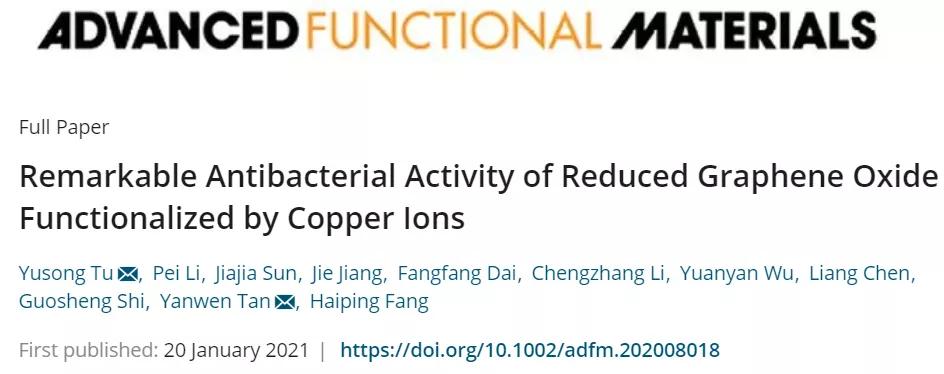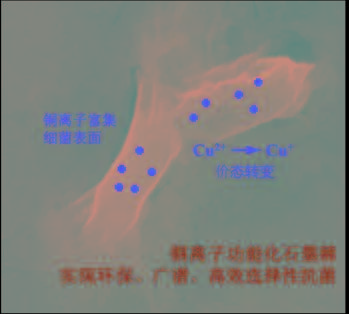Bacterial infections and their drug resistance are one of the biggest public health threats in the world. How to enhance antibacterial activity while minimizing environmental toxicity is one of the key issues. Although the antibacterial activity of copper has been known since ancient times, excessive copper ions themselves are extremely toxic and threaten environmental safety.
Recently, Professor Tu Yusong’s research group of Yangzhou University has cooperated with many domestic universities and research institutes to use copper ions to functionalize graphene to achieve selective and significant antibacterial activity, which greatly enhances the antibacterial activity of graphene and is non-toxic to mammalian cells. Compared with environmental copper ions, its antibacterial activity is increased by two orders of magnitude . Related papers were published on Adv. Funct. Mater . (DOI: 10.1002/adfm.202008018).

Tu Yusong and his collaborators studied the interaction between graphene and bacterial cell membrane in the early stage and found that the phospholipid molecules on the cell membrane can be extracted by graphene to cause the destruction of the cell membrane, and proposed a possible molecular mechanism of graphene antibacterial [Nat. Nanotechnol., 2013,, 8, 594-601]. This antibacterial molecular mechanism has quickly attracted widespread attention from domestic and foreign counterparts. People have tried to enhance its antibacterial activity through functionalized graphene in many ways, including cross-linking high-molecular polymers or adjusting the edge orientation of graphene, but the enhancement effect has failed. More than twice [Appl. Surf. Sci., 2015, 355, 446; Proc. Natl. Acad. Sci. USA, 2017, 114, E9793].

Figure 1: Graphene adsorbs a large amount of copper ions through the ionic π interaction between copper ions and graphene, showing unique functionality: not only quickly transports copper ions in large quantities and enriches the surface of bacteria, but also causes the valence of copper ions with each other. Change from +2 valence to +1, achieving selective and significant antibacterial activity.
They proposed the use of copper ions to functionalize the antibacterial mechanism of graphene. First, theoretical calculations show that graphene adsorbs a large amount of copper ions through the ionic interaction between copper ions and graphene to form graphene copper ion complexes; it is found that the graphene copper ion complexes with positive charge and negative charge The electrostatic interaction between the bacterial cell membranes, graphene exhibits unique functionality, that is, it not only quickly transports a large amount of copper ions and enriches the surface of the bacteria, but also causes the valence of copper ions to change from +2 to +1, thereby achieving significant Antibacterial activity. Further experiments have confirmed that functionalized graphene adsorbs copper ions, causing the concentration of copper ions in the environment to be lower than 0.5 µM, which meets the national surface water quality standard ; antibacterial experiments show that functionalized graphene with copper ions greatly enhances the antibacterial activity of graphene. Compared with environmental copper ions, its antibacterial activity is improved by two orders of magnitude.

FE-SEM and XPS experiments also proved that graphene transports copper ions in large quantities and enriches the surface of bacteria and the change in the valence state of copper ions adsorbed on graphene (see Figure 1), thus confirming the theoretically predicted functional antibacterial properties of graphene mechanism. By comparing the experiments of killing algae cells and mammalian cells, it further shows that such an antibacterial mechanism is effective for negatively charged cells, but does not work for mammalian cells that are neutral in nature, thus achieving selective Significant antibacterial activity. Since diseased cells such as cancer cells are also negatively charged cells, the discovered functional antibacterial mechanism of graphene also provides guidance for efficient and selective anti-cancer activity design. Graphene itself is easy to prepare and can also be easily removed by simple means such as centrifugation or filtration. Therefore, the antibacterial mechanism of graphene functionalized with copper ions has great applications in the design and preparation of cheap, convenient, efficient, broad-spectrum and environmentally friendly antibacterial materials prospect.
This work was completed by the cooperation of Yangzhou University, Fudan University, East China University of Science and Technology, Zhejiang Agriculture and Forestry University, Shanghai University and Shanghai Institute of Applied Physics. It was awarded the National Natural Science Foundation of China, Jiangsu Science and Technology Planning Project, Shanghai Science and Technology Major Project and Guangzhou Supercomputing Funding and support from the center.
Source: Yangzhou University
Paper link
https://onlinelibrary.wiley.com/doi/10.1002/adfm.202008018
Silicone Kitchen Utensils,Silicone Cooking Utensils,Silicone Utensil Set,Silicone Scraper
Garwin Enterprise Co.,Ltd , https://www.garwincn.com
